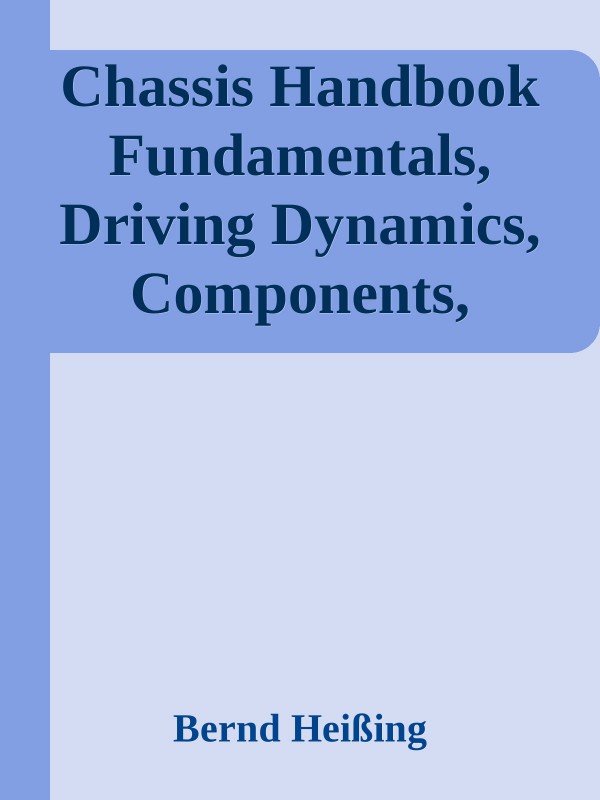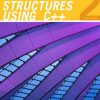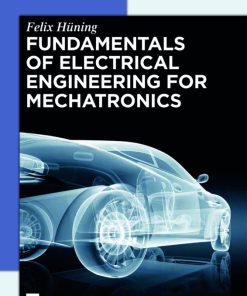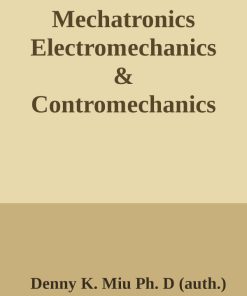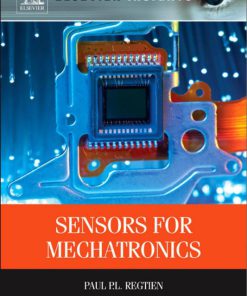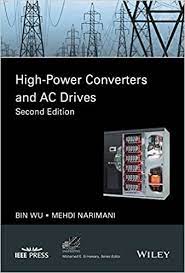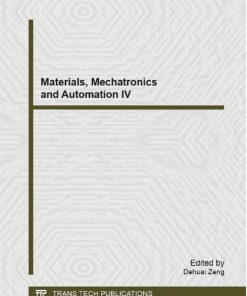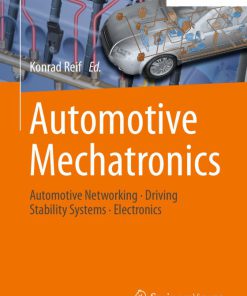(Ebook PDF) Chassis Handbook Fundamentals Driving Dynamics Components Mechatronics Perspectives 1st edition by Bernhard Heißing, ‎Metin Ersoy 3834897892 9783834897893 full chapters
$50.00 Original price was: $50.00.$25.00Current price is: $25.00.
Authors:Bernd Heißing , Series:Mechatronics Engineering [151] , Author sort:Heißing, Bernd , Languages:Languages:eng , Published:Published:Apr 2011 , Publisher:Vieweg+Teubner Verlag
Chassis Handbook Fundamentals, Driving Dynamics, Components, Mechatronics, Perspectives 1st edition by Bernhard Heißing, Metin Ersoy – Ebook PDF Instant Download/DeliveryISBN: 3834897892, 9783834897893
Full download Chassis Handbook Fundamentals, Driving Dynamics, Components, Mechatronics, Perspectives 1st edition after payment.

Product details:
ISBN-10 : 3834897892
ISBN-13 : 9783834897893
Author : Bernhard Heißing, Metin Ersoy
In spite of all the assistance offered by electronic control systems, the latest generation of passenger car chassis still relies on conventional chassis elements. With a view towards driving dynamics, this book examines these conventional elements and their interaction with mechatronic systems. First, it describes the fundamentals and design of the chassis and goes on to examine driving dynamics with a particularly practical focus. This is followed by a detailed description and explanation of the modern components. A separate section is devoted to the axles and processes for axle development. With its revised illustrations and several updates in the text and list of references, this new edition already includes a number of improvements over the first edition.
Chassis Handbook Fundamentals, Driving Dynamics, Components, Mechatronics, Perspectives 1st Table of contents:
1 Introduction and Fundamentals
1.1 History, Definition, Function, and Significance
1.1.1 History
1.1.2 Definition and Scope
1.1.3 Purpose and Significance
1.2 Chassis Design
1.2.1 Vehicle Classification
1.2.2 Powertrain Configurations
1.2.3 Chassis Composition
1.2.4 Trends in Chassis Composition
1.3 Chassis Layout
1.3.1 Chassis Requirements
1.3.2 Layout of Suspension Kinematics
1.3.3 Suspension Kinematics
1.3.3.1 Suspension Parameters Relative to Vehicle
1.3.3.2 Roll and Pitch Center
1.3.3.3 Wheel Travel
1.3.3.4 Wheel Travel Parameters
1.3.3.5 Steering Kinematic Parameters
1.3.3.6 Kinematic Parameters of Current Vehicles
1.3.3.7 Wheel Travel Curves
1.3.3.8 Wheel Kinematic Calculation Software
1.3.4 Elastokinematics and Component Compliances in Suspension Design
1.3.5 Target Parameter Values
1.3.6 Suspension Composition
2 Driving Dynamics
2.1 Driving Resistances and Energy Requirements
2.1.1 Driving Resistances
2.1.1.1 Rolling Resistance
2.1.1.2 Effect of Road Surface on Rolling Resistance FR,Tr
2.1.1.3 Aerodynamic Drag FA
2.1.1.4 Climbing Resistance FC
2.1.1.5 Inertial Resistance FI
2.1.1.6 Total Driving Resistance
2.1.2 Crosswind Response Behavior
2.1.3 Performance and Energy Requirements
2.1.4 Fuel Consumption
2.2 Tire Traction and Force Transfer to the Roadway
2.2.1 The Physics of Tire Traction and Force Transfer
2.2.1.1 Acceleration and Braking
2.2.1.2 Cornering
2.2.2 Detailed Tire Forces
2.3 Longitudinal Dynamics
2.3.1 Acceleration and Braking
2.3.1.1 Anti-Dive
2.3.1.2 Anti-Lift (Anti-Squat)
2.3.1.3 Load Changes During Straightline Driving
2.4 Vertical Dynamics
2.4.1 Springs
2.4.1.1 Spring Ratio
2.4.1.2 Natural (Eigen) Frequencies
2.4.2 Vibration Dampers
2.4.3 Excitations from the Roadway
2.4.3.1 Harmonic Excitations
2.4.3.2 Periodic Irregularities
2.4.3.3 Stochastic (Random) Irregularities
2.4.3.4 Spectral Density of Road Surface Irregularities
2.4.3.5 Measured Road Surface Irregularities
2.4.4 Tires as Spring/Damper Elements
2.4.5 Suspension Models
2.4.5.1 Single-Mass System
2.4.5.2 Dual-Mass System
2.4.5.3 Expansion of the Model to Include Seat Suspension Effects
2.4.5.4 Single-Track Suspension Model
2.4.5.5 Two-Track Suspension Model
2.4.6 Parameter Variation
2.4.7 The Roadway/Vehicle Connection
2.4.7.1 Spectral Density of Vehicle Body Accelerations
2.4.7.2 Spectral Density of Dynamic Wheel Loads
2.4.8 Human Oscillation Evaluation
2.4.9 Conclusions from the Fundamentals of Vertical Dynamics
2.5 Lateral Dynamics
2.5.1 Handling Requirements
2.5.2 Steering Kinematics
2.5.2.1 Static Steering Layout
2.5.2.2 Dynamic Steering Layout
2.5.3 Vehicle Modeling
2.5.3.1 Simple Single-Track (Bicycle) Model
2.5.3.2 Simple Vehicle Dynamics
2.5.3.3 Understeer and Oversteer
2.5.3.4 Expanded Single-Track Model with Rear-Wheel Steering
2.5.3.5 Nonlinear Single-Track Model
2.5.3.6 Analysis of Transient Behavior Using the Simple Single-Track Model
2.5.3.7 The Vehicle as Part of a Closed-Loop System
2.5.3.8 Dynamic Behavior of the Vehicle as Part of a Closed-Loop System
2.5.3.9 Slip Angle Compensation Using Rear-Wheel Steering
2.5.3.10 Investigation of Frequency Response for Varied Vehicle Configurations
2.5.3.11 Dual-Track Model
2.5.3.12 Parameter Variation
2.6 General Vehicle Dynamics
2.6.1 Interactions between Vertical, Longitudinal, and Lateral Dynamics
2.7 Chassis Control Systems
2.7.1 Definition of Terms
2.7.2 Limitations of the Passive Vehicle – Basic Goal Conflicts
2.7.3 The Driver-Vehicle Control Loop
2.7.4 Division of Chassis Control Systems into Domains
2.7.4.1 Longitudinal Dynamics
2.7.4.2 Lateral Dynamics
2.7.4.3 Vertical Dynamics
2.7.5 Requirements for Chassis Control Systems
2.8 Handling Characteristics
2.8.1 Handling Evaluation
2.8.2 Driving Maneuvers
2.8.3 Parameter Range of Maneuvers
2.8.4 Tuning Procedures
2.8.4.1 Tuning Procedures for Steady-State Steering Behavior
2.8.5 Subjective Handling Evaluation
2.8.5.1 Evaluation Methods and Representation
2.8.5.2 Acceleration (Driveoff) Behavior
2.8.5.3 Braking Behavior
2.8.5.4 Steering Behavior
2.8.5.5 Cornering Behavior
2.8.5.6 Straightline Driving Behavior
2.8.5.7 Ride Comfort
2.8.6 Objective Handling Evaluations
2.8.6.1 Measurement Parameters
2.8.6.2 Acceleration (Driveoff) Behavior
2.8.6.3 Braking Behavior
2.8.6.4 Steering Behavior
2.8.6.5 Cornering Behavior
2.8.6.6 Straightline Driving Behavior
2.8.6.7 Ride Comfort
2.9 Active and Passive Safety
3 Chassis Components
3.1 Chassis Structuring
3.1.1 Classification by Function
3.1.2 Modular Chassis Structure
3.1.3 Chassis Components
3.2 Drivetrain
3.2.1 Configurations
3.2.2 Axle Drives
3.2.2.1 Differentials
3.2.2.2 Locking Differentials
3.2.2.3 Active Differentials
3.2.2.4 Torque Vectoring
3.2.3 Four-wheel-drive (All-wheel-drive)
3.2.4 Control Strategies
3.2.5 Half-shafts
3.3 Wheel Brakes and Braking
3.3.1 Fundamentals and Requirements
3.3.2 Types of Braking Systems
3.3.2.1 General Requirements
3.3.3 Legal Regulations
3.3.4 Brake System Design
3.3.4.1 Brake Force Distribution
3.3.4.2 Dimensioning
3.3.5 Braking Torque and Dynamics
3.3.5.1 Braking Torque
3.3.5.2 Braking Dynamics
3.3.6 Brake System Components
3.3.6.1 Brake Calipers
3.3.6.2 Brake Discs
3.3.6.3 Brake Linings
3.3.6.4 Drum Brakes
3.3.6.5 Brake Fluid
3.3.6.6 Brake Force Booster
3.3.6.7 Tandem Master Cylinder
3.3.6.8 Human-Machine Interface (HMI)
3.3.7 Electronic Braking Control Systems
3.3.7.1 Brake Assistant (MBA, EBA, HBA)
3.3.7.2 Wheel Speed Sensors
3.3.7.3 Electronic Braking System Functions
3.3.7.4 Electrohydraulic Brake (EHB)
3.3.7.5 Electromechanical Brake (EMB)
3.3.7.6 Networked Chassis
3.4 Steering Systems
3.4.1 Requirements and Designs
3.4.2 Hydraulic Rack and Pinion Steering
3.4.2.1 Technology and Function
3.4.2.2 Design and Components
3.4.3 Steering Tie Rods
3.4.4 Steering Driveline and Steering Column
3.4.4.1 Components and Function Modules
3.4.4.2 Design and Testing
3.4.4.3 Crash Requirements and Energy Absorption Mechanisms
3.4.4.4 Future Prospects and Modularization
3.4.5 Electromechanical Steering Systems
3.4.5.1 Design Concepts
3.4.5.2 Configuration and Advantages
3.4.6 Active Steering and Superposition Steering
3.4.6.1 Functional Principles and Configuration
3.4.6.2 Functions – Present and Future
3.4.7 Rack and Pinion Power Steering with Torque and Angle Actuators
3.4.8 Rear-wheel and Four-wheel Steering Systems
3.4.9 Steer-by-wire and Single-wheel Steering Systems
3.4.9.1 System Configuration and Components
3.4.9.2 Technology, Advantages, Opportunities
3.5 Springs and Stabilizers
3.5.1 The Purpose of the Spring System
3.5.2 Design and Calculation of Steel Springs
3.5.2.1 Leaf Springs
3.5.2.2 Torsion Bar Springs
3.5.2.3 Stabilizers
3.5.2.4 Coil Springs
3.5.3 Spring Materials
3.5.4 Steel Spring Manufacture
3.5.4.1 Hot Forming
3.5.4.2 Heat Treating Hot Formed Springs
3.5.4.3 Cold Forming
3.5.4.4 Shot Peening
3.5.4.5 Plastification
3.5.4.6 Corrosion Protection
3.5.4.7 Final Inspection and Marking
3.5.5 Roll Control Using Stabilizers
3.5.5.1 Passive Stabilizers
3.5.5.2 Switchable Off-Road Stabilizers
3.5.5.3 Switchable On-Road Stabilizers
3.5.5.4 Semi-Active Stabilizers
3.5.5.5 Active Stabilizers
3.5.6 Springs for use with Automatic Leveling Systems
3.5.6.1 Purpose and Configurations
3.5.6.2 Leveling Using a Gas Spring
3.5.7 Hydropneumatic Springs
3.5.7.1 Self-Pumping Hydropneumatic Spring/Damper Elements
3.5.8 Air Springs
3.6 Damping
3.6.1 The Purpose of Damping
3.6.2 Telescopic Shock Absorber Designs
3.6.2.1 Twin-Tube Shock Absorbers
3.6.2.2 Monotube Shock Absorbers
3.6.2.3 Comparison of Damper Types
3.6.2.4 Special Designs
3.6.3 Coilover Shock Absorber and Strut
3.6.4 Shock Absorber Calculations
3.6.5 Additional Damper Features
3.6.5.1 Rebound and Compression Bump Stops
3.6.5.2 Stroke-Dependent Damping
3.6.5.3 Amplitude-Selective Damping
3.6.6 Damper End Mounts
3.6.7 Semi-Active Damping and Spring Functions
3.6.8 Alternative Damping Concepts
3.6.8.1 Magneto-Rheological (MRF) Dampers
3.6.8.2 Conjoined Damping
3.6.8.3 Load-Dependent Damping (PDC)
3.7 Wheel Control
3.7.1 Purpose, Requirements, and System Structure
3.7.2 Suspension Links: Purpose, Requirements, and System Structure
3.7.2.1 Control Arms (Control Links)
3.7.2.2 Support Links
3.7.2.3 Auxiliary Links
3.7.2.4 Suspension Link Requirements
3.7.2.5 Suspension Link Materials
3.7.2.6 Suspension Link Manufacturing Processes
3.7.2.7 Manufacturing Methods for Aluminum Suspension Links
3.7.2.8 Configuration and Optimization of Suspension Links
3.7.2.9 Integration of the Joints into the Link
3.7.3 Ball Joints
3.7.3.1 Purpose and Requirements
3.7.3.2 Types of Ball Joints
3.7.3.3 Ball Joint Components
3.7.3.4 Bearing System (Ball Race, Grease)
3.7.3.5 Sealing System (Sealing Boot, Retaining Ring)
3.7.3.6 Suspension Ball Joints
3.7.3.7 Preloaded Ball Joints
3.7.3.8 Cross Axis Ball Joints
3.7.4 Rubber Bushings
3.7.4.1 Purpose, Requirements, and Function
3.7.4.2 Types of Rubber Bushings
3.7.5 Pivot Joints
3.7.6 Rotational Sliding Joints (Trunnion Joints)
3.7.7 Chassis Subframes
3.7.7.1 Purpose and Requirements
3.7.7.2 Types and Designs
3.8 Wheel Carriers and Bearings
3.8.1 Types of Wheel Carriers
3.8.2 Wheel Carrier Materials and Manufacturing Methods
3.8.3 Types of Wheel Bearings
3.8.3.1 Bearing Seals
3.8.3.2 Lubrication
3.8.3.3 ABS Sensors
3.8.4 Wheel Bearing Manufacturing
3.8.4.1 Rings and Flanges
3.8.4.2 Cages and Rolling Elements
3.8.4.3 Assembly
3.8.5 Requirements, Design, and Testing
3.8.5.1 Bearing Rotational Fatigue Strength
3.8.5.2 Component Strength and Tilt Stiffness
3.8.5.3 Verification by Testing
3.8.6 Future Prospects
3.9 Tires and Wheels
3.9.1 Tire Requirements
3.9.1.1 Properties and Performance
3.9.1.2 Legal Requirements
3.9.2 Types, Construction, and Materials
3.9.2.1 Tire Types
3.9.2.2 Tire Construction
3.9.2.3 Tire Materials
3.9.2.4 The Viscoelastic Properties of Rubber
3.9.3 Transmission of Forces between the Tire and the Road Surface
3.9.3.1 Supporting Force
3.9.3.2 Adhesion Behavior and Lateral Force Buildup
3.9.3.3 Tangential Forces: Driving and Braking
3.9.3.4 Sideslip, Lateral Forces, and Aligning Moments
3.9.3.5 Sideslip Stiffness
3.9.3.6 Tire Behavior under Slip
3.9.3.7 Tire Uniformity
3.9.4 Tire Simulation Models
3.9.4.1 Tire Models for Lateral Dynamics
3.9.4.2 Tire Models Using Finite Elements (FEM)
3.9.4.3 Tire Models for Vertical Dynamics
3.9.4.4 Tire Vibration Modes
3.9.4.5 Cavity Natural Frequencies
3.9.4.6 Full Tire Models
3.9.5 Modern Tire Technologies
3.9.5.1 Tire Sensors
3.9.5.2 Run-Flat Tires
3.9.5.3 Tires and Control Systems
3.9.5.4 High Performance (HP) and Ultra High Performance (UHP) Tires
3.9.6 Vehicle Testing and Measurement
3.9.6.1 Subjective Test Procedures
3.9.6.2 Objective Test Procedures for Longitudinal Adhesion
3.9.6.3 Objective Test Procedures for Lateral Adhesion
3.9.6.4 Acoustics
3.9.7 Laboratory Testing and Measurement Methods
3.9.7.1 Basic Tire Test Rig Designs
3.9.7.2 Strength Tests
3.9.7.3 Measuring Tire Characteristics Using a Test Rig
3.9.7.4 Measuring Tire Characteristics Using a Vehicle-Mounted Test Rig
3.9.7.5 Measuring Tire Rolling Resistance
3.9.7.6 Measuring Uniformity and Geometry
3.9.7.7 Roadway Measurement and Modeling
3.9.7.8 Power Loss Analysis
3.9.7.9 Tire Temperature Measurement
3.9.8 The Future of Tire Technology
3.9.8.1 Material Developments
3.9.8.2 Energy Saving Tires
4 Axles and Suspensions
4.1 Rigid Axles
4.1.1 The De Dion Driven Rigid Axle
4.1.2 Rigid Axles with Longitudinal Leaf Springs
4.1.3 Rigid Axles with Longitudinal and Lateral Links
4.1.4 Rigid Parabolic Axles with a Central Joint and Lateral Control Links
4.2 Semi-Rigid Axles
4.2.1 Twist Beam Axles
4.2.1.1 Torsion-Type Twist Beam Axles
4.2.1.2 Standard Twist Beam Axles
4.2.1.3 Coupling-Type Twist Beam Axles
4.2.2 The Dynamic Twist Beam Axle
4.3 Independent Suspension
4.3.1 Independent Suspension Kinematics
4.3.2 The Advantages of Independent Suspension
4.3.3 Single-Link Independent Suspension Systems
4.3.3.1 Trailing Link Independent Suspension
4.3.3.2 Semi-Trailing Link Independent Suspension
4.3.3.3 Screw-Link Independent Suspension
4.3.4 Two-Link Independent Suspension
4.3.4.1 Lateral-Longitudinal Swing Axles
4.3.4.2 Trapezoidal Link with One Lateral Link (Audi 100 Quattro)
4.3.4.3 Trapezoidal Link with One Flexible Lateral Link (Porsche Weissach Axle)
4.3.5 Three-Link Independent Suspension
4.3.5.1 Central Link Independent Suspension
4.3.5.2 Double Wishbone Independent Suspension
4.3.6 Four-Link Independent Suspension
4.3.6.1 Rear Axle Multi-Link Independent Suspension
4.3.6.2 Multi-Link Suspension with Two Lower Two-Point Links
4.3.6.3 Trapezoidal (Integral) Link Suspension
4.3.6.4 Two Longitudinal and Two Lateral Links
4.3.6.5 One Longitudinal and Three Lateral Links
4.3.6.6 One Diagonal and Three Lateral Links
4.3.7 Five-Link Independent Suspension
4.3.7.1 Five-Link Front Suspension (SLA with two Decomposed 3-Point Links)
4.3.7.2 Five-Link Rear Suspension
4.3.8 Strut-Type Suspension Systems
4.4 Front Axle Suspension
4.4.1 Front Axle Suspension System Requirements
4.4.2 Front Axle Components
4.4.3 Front Axle Suspension Types
4.4.3.1 McPherson with Upper Strut Brace
4.4.3.2 McPherson with Optimized Lower Control Arm
4.4.3.3 McPherson with Decomposed Lower Control Arm
4.4.3.4 McPherson with Two-Piece Wheel Carrier
4.4.3.5 Double Wishbone with Decomposed Control Arms
4.5 Rear Axle Suspension
4.5.1 Rear Axle Suspension Requirements
4.5.2 Rear Axle Components
4.5.3 Rear Axle Suspension Types
4.5.3.1 Non-Driven Rear Axles
4.5.3.2 Driven Rear Axles
4.5.4 ULSAS Rear Axle Benchmark
4.6 Design Catalog for Axle Type Selection
4.7 The Chassis as a Complete System
4.7.1 Front / Rear Axle Interaction
4.8 Future Suspension Systems
4.8.1 Axles of the Past 20 Years
4.8.2 Relative Popularity of Various Current Axle Designs
4.8.3 Future Axle Designs (Trends)
5 Ride Comfort and NVH
5.1 Fundamentals: NVH and the Human Body
5.1.1 Concepts and Definitions
5.1.2 Sources of Vibrations, Oscillations, and Noise
5.1.3 Limits of Human Perception
5.1.4 Human Comfort and Well-Being
5.1.5 Mitigation of Oscillation and Noise
5.2 Bonded Rubber Components
5.2.1 Bonded Rubber Component Functions
5.2.1.1 Transferring Forces
5.2.1.2 Enabling Defined Movements
5.2.1.3 Noise Isolation
5.2.1.4 Vibration Damping
5.2.2 The Specific Definition of Elastomeric Components
5.2.2.1 Force-Displacement Curves
5.2.2.2 Damping
5.2.2.3 Setting
5.3 Engine and Transmission Mounts
5.4 Chassis and Suspension Mounts and Bushings
5.4.1 Rubber Bushings
5.4.2 Sliding Bushings
5.4.3 Hydraulically-Damped Bushings (Hydro Bushings)
5.4.4 Chassis Subframe Mounts
5.4.5 Upper Strut Bearings and Damper Mounts
5.4.6 Twist Beam Axle Mounts
5.5 Future Component Designs
5.5.1 Sensors
5.5.2 Switchable Chassis Mounts
5.6 Computation Methods
5.7 Acoustic Evaluation of Bonded Rubber Components
6 Chassis Development
6.1 The Development Process
6.2 Project Management (PM)
6.3 The Planning and Definition Phase
6.3.1 Target Cascading
6.4 The Concept Phase
6.5 Computer-Aided Engineering
6.5.1 Multi-Body Simulation (MBS)
6.5.1.1 MBS Chassis and Suspension Models in ADAMS/Car
6.5.1.2 CAD Chassis Models and Multi-Body Systems
6.5.1.3 Multi-Body Simulation with Rigid and Flexible MBS
6.5.1.4 Multi-Body Simulations Using Whole-Vehicle, Chassis, and Axle Models
6.5.1.5 Effects of Manufacturing Tolerances on Kinematic Parameters
6.5.2 Finite Element Method (FEM)
6.5.2.1 Classification of Analyses
6.5.2.2 Strength Analyses
6.5.2.3 Stiffness Analyses
6.5.2.4 Natural Frequency Analyses
6.5.2.5 Service Life and Durability Analyses
6.5.2.6 Crash Simulations
6.5.2.7 Topology and Shape Optimization
6.5.2.8 Simulations of Manufacturing Processes
6.5.3 Whole-Vehicle Simulations
6.5.3.1 Vehicle Handling and Dynamic Simulations
6.5.3.2 Kinematics and Elastokinematics
6.5.3.3 Standard Load Cases
6.5.3.4 MBS Model Verification
6.5.3.5 NVH
6.5.3.6 Loads Management (Load Cascading from Systems to Components)
6.5.3.7 Whole-Vehicle Durability Simulations
6.5.3.8 Whole-Vehicle Handling Fingerprint
6.5.3.9 Specification of Elastokinematics Using Control-System Methods
6.5.4 3D Modeling Software (CAD)
6.5.5 Integrated Simulation Environment
6.5.5.1 Kinematic Analysis Using ABE Software
6.5.5.2 The Virtual Product Development Environment (VPE)
6.6 Series Development and Validation
6.6.1 Design
6.6.1.1 Component Design
6.6.1.2 Package Volume
6.6.1.3 Failure Mode and Effects Analysis (FMEA)
6.6.1.4 Tolerance Investigations
6.6.2 Validation
6.6.2.1 Prototypes
6.6.2.2 Validation Using Test Rigs
6.6.2.3 Roadway Simulation Test Rig
6.6.3 Whole-Vehicle Validation
6.6.4 Optimization and Fine-Tuning
6.7 Development Activities During Series Production
6.8 Summary and Future Prospects
7 Chassis Control Systems
7.1 Chassis Electronics
7.2 Electronic Chassis Control Systems
7.2.1 Domains
7.2.2 Longitudinal Dynamic Control Systems – Wheel Slip Regulation
7.2.2.1 Braking Control
7.2.2.2 Electronically-Controlled Center Differentials
7.2.2.3 Torque-On-Demand Transfer Cases
7.2.2.4 Electronically-Controlled Axle Differentials
7.2.2.5 Axle Drive for Lateral Torque Distribution
7.2.3 Lateral Dynamic Control Systems
7.2.3.1 Electric Power Steering Systems (EPS)
7.2.3.2 Superimposed Steering
7.2.3.3 Active Rear-Wheel Steering
7.2.3.4 Active Rear-Axle Kinematics
7.2.4 Vertical Dynamic Control Systems
7.2.4.1 Variable Dampers
7.2.4.2 Active Stabilizers
7.2.4.3 Active Leveling Systems
7.2.5 Safety Requirements
7.2.6 Bus Systems
7.2.6.1 CAN
7.2.6.2 FlexRay
7.3 System Networking
7.3.1 Vehicle Dynamic Control (VDC)
7.3.2 Torque Vectoring
7.3.3 Vertical Dynamic Management
7.4 Functional Integration
7.4.1 System Architecture
7.4.2 Standard Interfaces
7.4.3 Smart Actuators
7.5 Chassis Control System
7.5.1 Simulation Models
7.5.2 Hardware-in-the-Loop Simulation
7.6 Mechatronic Chassis Systems
7.6.1 Longitudinal Dynamics
7.6.1.1 Powertrain Systems
7.6.1.2 Braking Systems
7.6.2 Lateral Dynamics
7.6.2.1 Front-Wheel Steering Systems
7.6.2.2 Rear-Wheel Steering Systems
7.6.2.3 Roll Stabilization Systems
7.6.2.4 Active Kinematics
7.6.3 Vertical Dynamics
7.6.3.1 System Requirements
7.6.3.2 Classification of Vertical Dynamic Systems
7.6.3.3 Damping Systems
7.6.3.4 Active Leveling Systems
7.6.3.5 Current Active Spring Systems
7.6.3.6 Fully Active Integrated Suspension Systems
7.6.3.7 Pivots (Bushings, Joints, Mounts)
7.7 X-by-wire
7.7.1 Steer-by-wire
7.7.2 Brake-by-wire
7.7.2.1 Electrohydraulic Braking (EHB)
7.7.2.2 Electromechanical Braking (EMB) Systems
7.7.2.3 The ContiTeves Electromechanical Brake
7.7.2.4 Radial (Full-Contact) Disc Brakes
7.7.2.5 Wedge Brake
7.7.3 Leveling-by-wire
7.8 Driver Assistance Systems
7.8.1 Braking Assistance Systems
7.8.1.1 Safety-Relevant Braking Assistance
7.8.1.2 Comfort-Oriented Braking Assistance
7.8.1.3 Braking Assistance System Requirements
7.8.2 Distance Assistance Systems
7.8.3 Steering Assistance Systems
7.8.3.1 Steering Assistance Using Adaptive Assistance Torques
7.8.3.2 Steering Assistance Using Additional Steering Torque
7.8.3.3 Steering Assistance Using a Supplemental Steer Angle
7.8.3.4 Summary
7.8.4 Parking Assistance Systems
7.8.4.1 Introduction
7.8.4.2 Parking Space Recognition
7.8.4.3 Parallel Parking
7.8.4.4 Steering Actuators
8 The Future of Chassis Technology
8.1 Chassis System Concepts – Focus on Customer Value
8.1.1 Choosing Handling Behavior
8.1.2 Diversification of Vehicle Concepts – Stabilization of Chassis Concepts
8.1.2.1 Front Suspension as of 2004
8.1.2.2 Rear Suspension as of 2004
8.1.3 The Future of Chassis Subsystems and Components
8.1.3.1 The Future of Axle Drive Units
8.1.3.2 The Future of Braking Systems
8.1.3.3 The Future of Steering Systems
8.1.3.4 The Future of Suspension Spring Systems
8.1.3.5 The Future of Dampers
8.1.3.6 The Future of Wheel Control Components
8.1.3.7 The Future of Wheel Bearings
8.1.3.8 The Future of Tires and Wheels
8.2 Electronic Chassis Systems
8.2.1 Electronic Assistance Systems and Networking
8.2.2 Networking Chassis Control Systems
8.2.2.1 Peaceful Coexistence
8.2.2.2 Integral Control
8.2.2.3 Networked Control
8.2.2.4 Performance / Efficiency
8.2.2.5 System Safety
8.2.2.6 The Development Process
8.2.2.7 Data Transmission Requirements
8.2.2.8 Summary
8.3 The Future of X-by-Wire Systems
8.4 Intelligent and Predictive Future Chassis Systems
8.4.1 Sensors
8.4.2 Actuators
8.4.3 Predictive Driving
8.5 Hybrid Vehicles
8.6 The Rolling/Driving Chassis
8.7 The Vision of Autonomous Vehicle Control
8.8 Future Scenarios for Vehicle and Chassis Technology
8.9 Outlook
People also search for Chassis Handbook Fundamentals, Driving Dynamics, Components, Mechatronics, Perspectives 1st:
chassis handbook fundamentals driving dynamics pdf
chassis engineering pdf
chassis handbook fundamentals driving dynamics components mechatronics
cdx fundamentals of automotive technology answers
fundamentals of automotive technology principles and practice pdf

